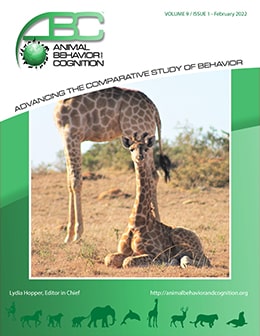Vol 9, Issue 1, February 2022
Are Wild Wolves Southpaws? Including Potential Conservation Implications
Citation
Barber-Meyer, S. M. (2022). Are wild wolves southpaws? Including potential conservation implications. Animal Behavior and Cognition, 9(1), 72-79. https://doi.org/10.26451/abc.09.01.06.2022
Abstract
Lateralization, or a left-right bias in behavior (e.g., handedness), was originally thought to exclusively exist in humans, but is now known to be widespread. Lateralization can exist at the individual or group level. In dogs (Canis lupus familiaris), tests of paw preference have produced inconsistent results. Because wolves (C. l.) differ genetically, morphologically, and behaviorally from dogs, I was interested in assessing them for lateralization. I examined lateralization (right versus left) of the foot captured (a step test analog) of wild wolves (n = 93) trapped for radiocollaring purposes in the Superior National Forest, Minnesota from 2011 – 2017 and 2019. No support was found for lateralization, and sex and age class were not significant predictors of which foot was captured. Because many mammals demonstrate lateralization, and because population-level lateralization is thought to convey increased social cohesion, it is surprising that wild wolves did not demonstrate population level lateralization. This step test analog may not have been an appropriate measure (as lateralization is task dependent) and / or wolf lateralization may exist at the individual level, but not the population level. Future work on wolf lateralization at both the individual and population levels examining pawedness via multiple tasks while accounting for potential confounding factors (such as different rearing conditions and methods) could provide clarification. Examining potential trade-offs between the costs and benefits of lateralization that these highly social animals may incur would be very interesting in terms of evolution and in comparison with dogs. Furthermore, because lateralization has been connected to emotional functioning and animal welfare, baseline lateralization data from wild wolves may inform captive wolf management and conservation, including the captive breeding programs for endangered Mexican wolves (C. l. baileyi) and red wolves (C. rufus) and other programs (e.g., educational facilities).
Keywords
Canis lupus, Foot-hold trapping, Gray wolves, Handedness, Laterality, Paw preference, Pawedness
